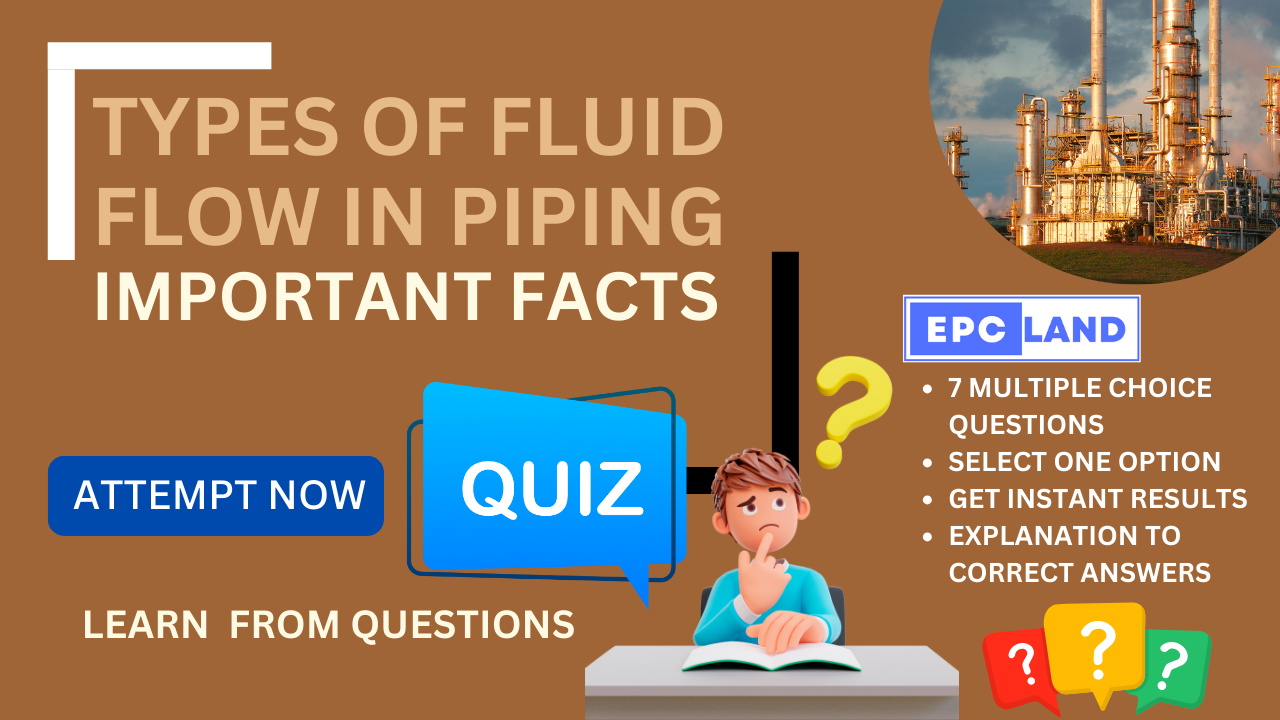1. Particle Motion in Laminar Flow
How do fluid particles move in laminar flow?
Explanation: In laminar flow, fluid particles move smoothly and orderly along the length of the pipe with little or no sideways motion.
2. Boundary Layer in Turbulent Flow
What is the characteristic of the boundary layer in turbulent flow?
Explanation: The boundary layer in turbulent flow is thin, as the fluid particles at the wall are not strongly slowed down by friction.
3. Viscous Forces in Laminar Flow
How are the viscous forces in laminar flow compared to turbulent flow?
Explanation: Viscous forces in laminar flow are strong, preventing fluid particles from mixing freely.
4. Equations for Turbulent Flow
How would you describe the equations for turbulent flow compared to laminar flow?
Explanation: The equations for turbulent flow are more complex compared to the simpler equations for laminar flow.
5. Examples of Turbulent Flow
Which of the following is an example of turbulent flow?
Explanation: Water flowing through a river is an example of turbulent flow.
6. Mixing in Turbulent Flow
How do particles move in turbulent flow?
Explanation: In turbulent flow, fluid particles move in a random and disorganized fashion, freely mixing across the pipe.
7. Boundary Layer Thickness
How does the thickness of the boundary layer change with increasing velocity in laminar flow?
Explanation: The thickness of the boundary layer increases with increasing velocity in laminar flow.
Short Article on Types of Fluid Flow
Types of Fluid Flow
When a fluid moves through a pipe, two distinct types of flow are possible: laminar and turbulent.
Laminar flow occurs in fluids moving with small average velocities. In laminar flow, the fluid particles move along the length of the pipe in a very orderly fashion, with little or no sideways motion across the width of the pipe. This is because the viscous forces acting between the fluid particles are strong enough to prevent them from mixing.
Turbulent flow becomes apparent as the velocity of the fluid is increased above a critical velocity. In turbulent flow, the fluid particles move in a random, disorganised fashion, from side to side across the pipe as well as along its length. This is because the viscous forces acting between the fluid particles are not strong enough to prevent them from mixing.
There will, however, always be a layer of laminar flow at the pipe wall – the so-called “boundary layer”. This is because the fluid particles at the wall are slowed down by friction with the wall. The thickness of the boundary layer increases with increasing velocity.
The two types of fluid flow are described by different sets of equations. In general, for most practical situations, the flow will be turbulent.
Here is a table summarizing the key differences between laminar and turbulent flow:
| Feature | Laminar flow | Turbulent flow |
|---|---|---|
| Particle motion | Smooth, orderly | Random, disorganised |
| Mixing | Little or no mixing | Particles mix freely |
| Viscous forces | Strong | Weak |
| Boundary layer | Thick | Thin |
| Equations | Simpler | More complex |
drive_spreadsheetExport to Sheets
Here are some examples of laminar and turbulent flow:
- Laminar flow:
- Blood flowing through capillaries
- Smoke rising from a cigarette
- Turbulent flow:
- Water flowing through a river
- Air flowing around an airplane wing
Table of Contents
Don’t miss the Course on Effective Isometrics Management: Check Now
Enrollment Link
Recommended courses (Published on EPCLand)
- Complete Course on Piping Engineering
- Basics of Piping Engineering
- Piping Layout Engineering
- Piping Material Engineering
- Piping Stress Analysis
- Material Requisitions
- Piping Material Specifications
- Valve Material Specifications
- Plant Design & Layouts-OISD 118
- Isometric Management
Library of Technical Articles
Don’t miss out the collection of 15+ articles on following topics:
- Basics of Oil and Gas Industry
- Valves
- Testing
- Tank
- Piping Bulk Items
- Pipe
- Metallurgy
- Piping Materials
- Layout
- Instrumentation
- Heat Exchanger
- Type of Contracts
- Codes and Standards
- ASTM Standards
- Articles on Piping Specialty Items
Video details of Complete Course on Piping Engineering
Why Enroll in the EPCLand
Proven Track Record– PTR
Activities & Achievements before launching EPCLand
- Published more than 50+ short courses
- 3000+ Enrolments
- More than 3,500,00 Minutes of watch hours in the last 2 years
- 4000+ Students in 100+ Countries
- Rating of 4+ out of 5
- 1000+ YouTube Videos
- 8K+ Subscribers
What Students will Learn
- Codes & Standards of the Energy Sector
- Piping Material Engineering
- Piping Layout Engineering
- Stress Analysis
Interesting facts
- All the published courses have been developed by Industry Experts with more than 2 decades of experience
- Content is based on Practical experience and real-time problems.
- Content is designed and organized in such a manner that it can be easily grabbed.
- Complete website, Blogs and Quiz sections are Planned, Designed and published by myself (About me: Atul Singla)
- Complete flexibility of Time & Location, Students can access the content from anywhere & anytime
- Moreover, once enrolled, the content can be access as many times as you want, which helps in understand the fundamentals in a better way.
Conclusion
In conclusion, our courses are meticulously crafted by industry experts with over two decades of hands-on experience. The content is rooted in practical knowledge, addressing real-time problems. The material is thoughtfully designed and organized for easy comprehension. Every aspect, from the website to blogs and quizzes, has been planned, designed, and executed by Atul Singla, ensuring a comprehensive and seamless learning experience. With the flexibility of accessing the content at any time and from any location, students have the freedom to learn on their terms. Furthermore, enrollment grants unlimited access, allowing learners to revisit the material as often as needed, fostering a deep understanding of the fundamentals.



